It's no secret: Amazon is a big deal. In fact, 200 million unique monthly customers prefer making their purchases with Amazon over any other store. In 2019 they impressively reported that small and medium sized businesses sold about 4,000 items per minute. In light of these numbers, it is obvious that all retailers should at least consider listing their products on Amazon.
It's a very attractive sales channel for online merchants. However, the results an individual retailer will get depends on many factors and what works for one retailer will not necessarily work for another one. We'll break down the pros and cons of selling on Amazon as well as go over everything else you should consider before making a decision.
Grow your Amazon revenue with a practical checklist to Amazon Pricing Strategies
The Pros of Selling on Amazon
How Amazon has brilliantly achieved to carve out a piece of our brains and establish itself as the number one place for many shoppers, has become the topic of many marketing study cases. What we want to look at today is how much a retailer has to gain if they decide to sell products with the giant colossus.
These are the 4 main benefits of selling on Amazon:
1. More sales
Each month millions of active customers visit Amazon looking to shop for products.
And the numbers don't lie: 2019 ended with the website gaining over$280.5 billion in revenue and 150 Prime members worldwide. We can see that Amazon is the number 1 place to go for most shoppers.
By listing their products on Amazon, every retailer automatically gains credibility and trust. That's because some users are more likely to buy a product from Amazon rather than from a shop they never heard of. Amazon's promise of excellence and great service entices many shoppers into buying the products from their website. They likely have had a good experience purchasing on Amazon before, so your shop automatically benefits from that.
In countries where online shopping hasn't yet gained full traction, most shoppers trust Amazon over almost any other online store. It's turned into a household name, especially now that more than 100 million Alexa devices have sold worldwide. It's even possible for shoppers to make voice activated purchases.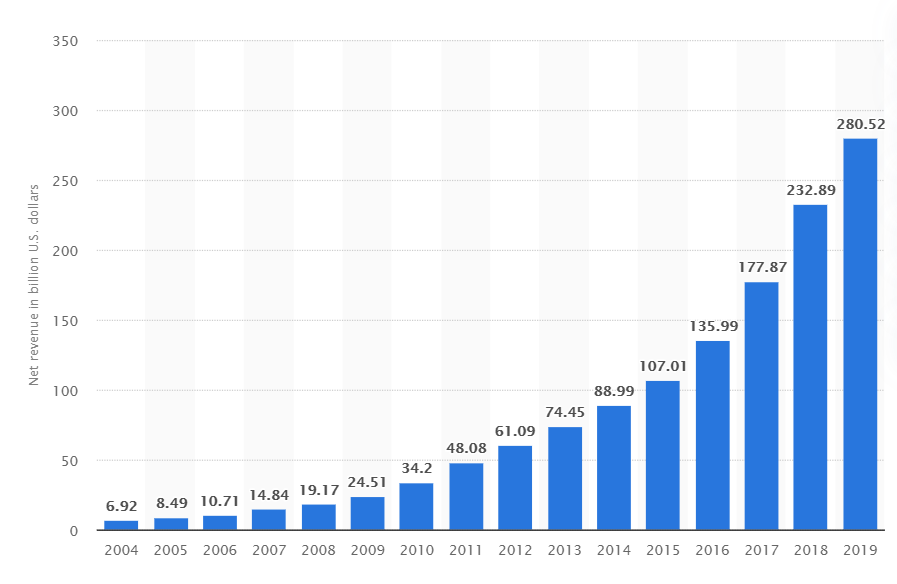
Gaining new customers
Speaking of more sales, Amazon can help you build your customer base. When shoppers head to Amazon their focus is usually on finding products rather than a specific store. But that can work to your advantage.
The benefit here is that shoppers can come across products their interested in, and in doing so, discover your shop.
Once they make that first purchase with you, the future lies in your hands. Based on how good their experience was, there’s a higher chance you’re going to see them again. Charm them with amazing service and you’ve got a repeat customer.
Here's a few tips on how to boost your sales on Amazon.
2. International Expansion
Since Amazon is one of the biggest and most trusted global selling and buying platforms, it's very easy to start selling in different markets. While they’ve only launched sites for 13 countries, they do ship to over 100 countries worldwide. It’s just down to the shopper if they’re potentially willing to pay a higher shipping fee based on their location.
Using Amazon to expand globally is drastically easier when compared with most shopping cart systems. Magento offers Multiple Store views, but others require you to create a new shop for each different language. That’s a lot of work without even knowing how the product will perform in that market.
With Amazon, any retailer can quickly test if his products appeal to the global audience by creating a listing on a local Amazon. They’ve got you covered for every aspect including international order fulfillment and localized customer support. It takes the heavy lifting off your shoulders since you don't have the hassle of figuring out local payment systems, logistics, and operations.
Let’s say you’re based in the US, but would like to expand to Europe. Here’s how you could list internationally:
-
Decide where you want to expand
-
Register in that market and list your products
-
Create a plan for shipping and fulfillment
-
Use Amazon’s tool to manage your business and sales

3. Low marketing costs
Amazon already attracts millions of customers to their website daily, and you get access to them. Depending on your niche and how crowded the market is you can start selling from day one without any significant marketing efforts whatsoever. Because the Amazon website works as its own search engine, shoppers seeking out the products you offer can easily find you.
Of course, the competition is fierce and you need to stand out from the crowd. Having a curated presence will help your efforts of piggybacking on Amazon's huge client database. Any effort you put in to perfecting your listings has the ability to really pay off.
That said, we’re not advocating for you to completely dismiss the idea of advertising on Amazon altogether as it can raise your visibility on the search results page.
If you do decide to advertise on Amazon, there are 4 types to choose from:
- Sponsored Products
- Sponsored Brands
- Lockscreen Ads (for book vendors and Kindle Direct Publishing authors)
- Sponsored Display
In this image (from the top of the search results page) you can see the sponsored products positioned right before the non-sponsored one.
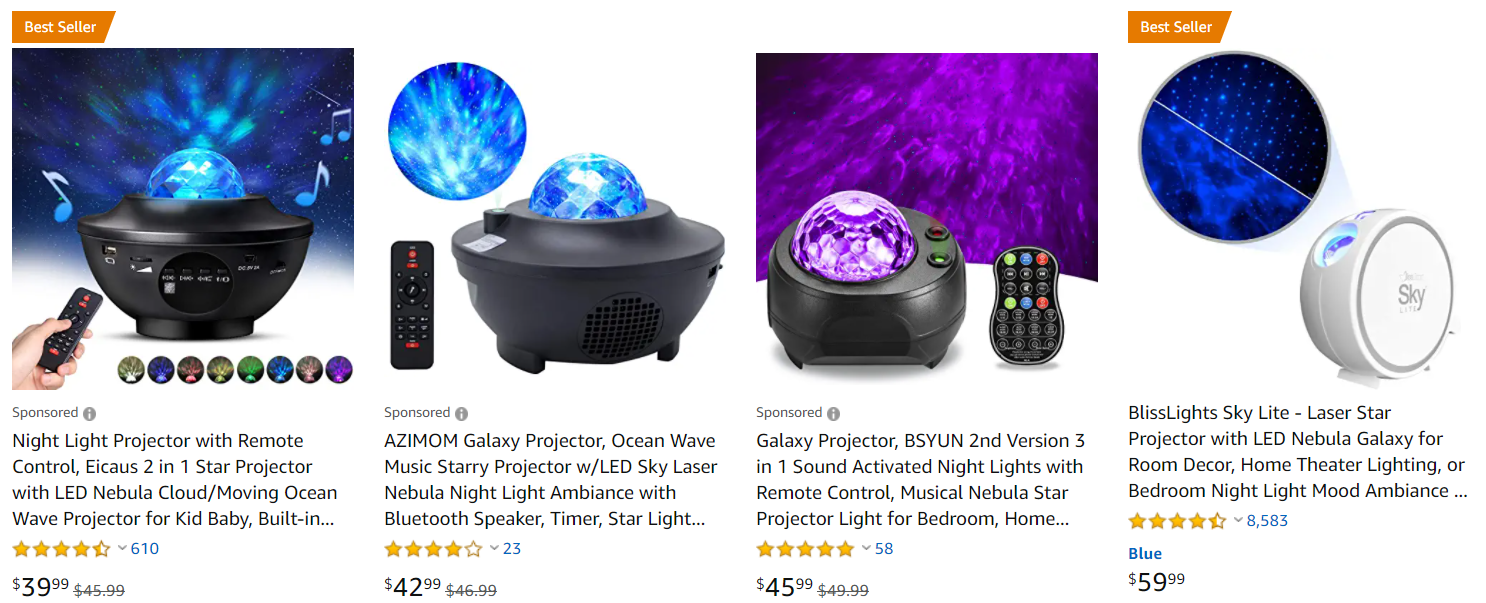
4. No stock
With more than 175 fulfillment centers around the globe, you can ship all your products in bulk to Amazon and they will store your inventory, package it and ship it to your customers. Easy!
The main benefit of this is that you don’t have to get bogged down with the practicalities of shipping out products. You can focus on managing other important business operations while joyfully watching your orders increase.
Amazon FBA (Fulfillment By Amazon) is your inventory warehouse, manager, and shipper for a very small amount, compared to what you'd have to pay otherwise. On top of freeing yourself from the hassle, your products will qualify automatically for Amazon Prime shipping and Buy Box priority, which will hugely impact your overall sales. Seeing that Prime logo is a great incentive to shoppers.
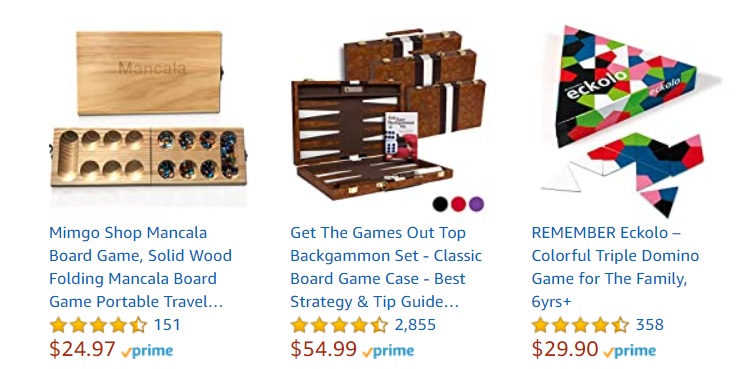
The Cons of Selling on Amazon
Even if no one can contest the numerous advantages of selling your inventory on Amazon, it's not all roses and there are many things to consider before taking the leap. Things like high competition, high selling fees, and order management will have an impact on your strategy and pricing and therefore need to be considered carefully.
These are the 4 main hurdles for merchants to start selling on Amazon:
1. High competition
You probably saw this one coming, and yes, the competition is fierce. A long-term strategy is essential.
If you're selling the same product as other merchants then you'll be competing with them for the Amazon Buy Box. Unlike with Google Shopping, which organizes product pages by sellers, Amazon's pages are ordered by products.
So, when multiple sellers have the same product on sale, Amazon will decide which seller is the best fit. When a customer clicks the Add to Cart button then the items of the featured seller will be added to their shopping cart.
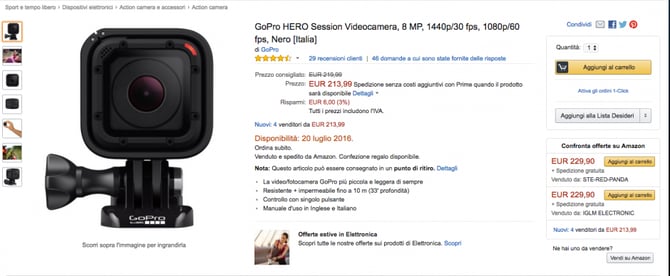
There may be dozens of sellers offering the same product, but only one seller will have the highest Buy Box Score and ultimately win the sale.
As always, the winner takes it all. Given the current mobile shopping trends the Buy Box is even more important on mobile devices where people are less inclined to scroll down and review other sellers.
Furthermore, when new entrants hit the Amazon Marketplace scene, the competition increases.
We don’t know the exact formula for winning because Amazon continually updates the variables considered when determining the winner. Luckily, we do have a pretty good idea of the main ingredients for the score, and there are ways to improve it.
Focus on acing these elements:
- Stellar feedback
- Fulfilling orders on time
- FBA
- Customer service
- Having competitive prices
- Availability that’s up-to-date
There are several other ways of increasing your score. By using an order management system, merchants sync their inventory, so their availability is always up-to-date. Orders can be fulfilled (and reported back to Amazon) in real time, which will bring down fulfillment time.
Cracking the Buy Box code is impossible, but improving the responsiveness to customer orders, increasing the speed of fulfillment, reducing the number of orders that have been cancelled, having an updated inventory and solid order management are all significant factors to winning the Amazon game.
2. Selling fees
Understanding the financial implications of using Amazon's platform is crucial, also when it comes to Amazon FBA taxes. All those benefits we listed first don't come for free. Amazon charges retailers hefty commission for every product sold through them. It’s best to have a good idea of what those monthly fees will look like for you before starting.
Let’s break down all the costs involved. When registering your business account you’ll have the option of choosing between two different account types.
Amazon’s two selling plans are:
- Professional - $39.99/mo with no per item fee
- Individual - no subscription fee but $0.99 fee per item sold
The Individual Selling plan is right for you if you’re not quite sure what you’re going to be selling yet, or you sell less than 40 items a month. Otherwise, it’s best to go with the Professional plan.
Regardless of the plan, sellers will need to pay a referral fee for every item that’s sold. The amount of this fee varies by the category of the product sold. You can see a full list of these fees on Amazon’s Seller Central site. Depending on the category, it could range from 8% to 96%.
FBA fees
If you choose to go with the FBA route then there are other fees you’ll need to consider as well. You’ll have fulfillment fees per item as well as monthly storage costs.
For example, if you sell large, standard size apparel items (10oz or less) then your fulfillment fee will be $3.70 per item.
Monthly inventory storage fees are calculated by cubic foot. So let’s say you’re renting a spot for oversized items for the whole year. You’d then pay $0.48 (per cubic foot) from January to September and $0.75 from October to December.
Should the fees discourage you?
With shopping channels you pay for every click, no matter if that click converts or not. With marketplaces such as Amazon, you pay a percentage of each sale. Because of that you need to ensure that your margins are high enough in order to be successful.
If you're selling goods in low-margin categories then you probably need to navigate towards other places, because the numbers just won't add up. On the other hand, if the numbers check out you can make selling on Amazon work for you with some planning.
3. Order Management
If you're selling your inventory on multiple marketplaces syncing orders is one of the first things you need to think of. You need to ensure that Amazon orders are directly brought into your system for a constantly up-to-date central order management system.
Amazon doesn’t integrate with shopping cart systems. That leaves merchants selling their products on multiple channels in a very challenging position to manage orders and keep their stock status up to date.
When an Amazon seller receives an order, the process often goes like this:
- The merchant downloads the orders from Amazon by the end of the day
- The merchant ships the products
- Then they report back (status update) to Amazon
This process has two big disadvantages for sellers:
- The stock status in Amazon will only be updated after fulfilling the orders, so during the day a retailer may be selling products that are actually sold out.
- The retailer also needs to deal with two different fulfillment systems: one for orders in his store and one from Amazon.
Thankfully there are plenty of 3rd party tools on the market that will help you and ensure that the number of items available in your shopping cart is always up-to-date.

At DataFeedWatch we offer Amazon Order Management for our Magento and Shopify users. This ensures that merchants never advertise out of stock products nor waste money on clicks that don’t convert. Stock statuses will always be up-to-date and orders from Amazon are processed just like products sold in the online store.
4. Complex data feed
Amazon wants to receive updated product data every day. They also have very specific requirements. That means that merchants need to create a dedicated Amazon feed from scratch.
All products must have an ASIN-number and all uploads must be done via the Amazon-API. Connecting with an API requires technical development that is too complex and too costly for merchants.
There are a couple of ways that you can add products to Amazon. They are:
- Individually adding the products, filling out the data manually one-by-one
- Adding your product data to an inventory file (spreadsheet) and uploading it
- Using an automated feed tool.
The first option may be manageable if you don’t have a lot of products to add. But if you already have a data source (for example Shopify or another shopping cart) then the solution is simply to rely on a 3rd party data feed tool to cover the technical stuff.
A tool like ours connects to Amazon on behalf of the retailer and assigns the ASINs automatically. The only thing that a merchant needs to do is enter in their Amazon credentials. With simple templates for all product types, an online retailer can create all required data feeds in a matter of minutes.
Selling on Amazon vs. your own site
As a retailer, you might be asking yourself “Why don’t I just sell on my own site instead?”. And it’s a valid question to ask.
Choosing Amazon
Selling on Amazon does give you automatic credibility as a seller. Buyers are quick to trust that you’re reputable when they see you have a well-made Amazon product page. Yes, you do need to pay referral fees for items you sell but it could turn out being worth the traffic it brings you.
Another benefit of forgoing your own website is that there’s a lot less maintenance for you to worry about. You won’t need to spend time fixing technical issues or on website upkeep.
Amazon restrictions
Selling on Amazon limits your customer interaction to the Buyer-Seller Messaging Service. All communication strictly needs to be about fulfilling the order, and nothing else. Because of this, building your brand outside of the Amazon platform is inhibited.
Any requested reviews need to be done in a neutral way. Some methods of doing this are through product inserts or the Request a Review button.
Amazon is always upping the restrictions in this area to avoid fake or biased reviews. For example, asking for things like positive reviews goes against the Terms of Service.
Choosing your own site
Selling on your own site does have its own perks apart from having full control. For example, during word of mouth situations. When someone buys an item on Amazon, they’re less likely to drop the name of the seller when asked where they bought it. “I bought it on Amazon” is a frequently heard phrase.
If they bought the item directly from your website, your name is more likely to be brought into the conversation. However, it can be argued that if you’re already winning the Buy Box then the person looking for that same item is likely to find you as well. You can easily create your own e-commerce website by using an established platform like Shopify or even a standard CMS or website builder tool.
Verdict
At the end of the day, it’s entirely possible to not have to choose. If you’re up for it, you can get the best of both worlds. Selling on your own site and Amazon is always an option.
Who is Amazon good for and why?
Small and medium sized businesses typically need to ask themselves different questions than larger corporations need to. So, is selling on Amazon worth it for you?
The answer is yes if:
- You’re able to be competitive with your prices. This will help prevent you from getting lost in the crowd.
- You're able to comply with the regulations (for example, responding to customer messages within the required 24 hour time period).
- If you’re selling unique or niche items (including refurbished or used). The less competition you have, the better.
- You’re not competing directly with items Amazon sells itself (for example, Amazon Essentials)
Amazon even has a section of their website dedicated to supporting small businesses. You can find resources and testimonials there.
In their 2020 SMB Impact report, Jeff Wilke states that “supporting small and medium-sized businesses (SMBs) is a fundamental part of our work and an extension of our customer-centric culture”.
They’ve laid out some of the numbers here:
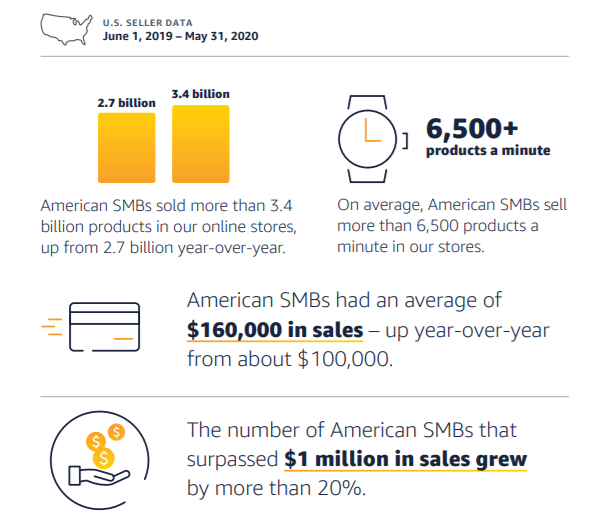
Final thoughts
Ultimately, the decision is yours. But now you have more food for thought to fuel the route you decide to choose.
In short, for some merchants, Amazon Marketplace could turn out to be beneficial to their retail strategy, but for others it will not work from the start. Irrespective of whether or not you sell on Amazon, the point is that you need to diversify the revenue streams and never keep all eggs in one basket.
Selling on Amazon is not as simple as via Google Shopping, for example. There are other potential issues like Amazon not integrating with the shopping carts.
On top of that, the increased competition requires a flawless order and inventory management to guarantee customer satisfaction. It’s not unachievable, but it does require a lot of planning and forethought.
Other Amazon articles you may find useful:
- What is Amazon ASIN number & how to get it?
- Fixing the Most Common Amazon Errors
- Amazon Pricing Strategies - What You Need To Know
- Seller Guide to Creating the Best Amazon Product Listings
- The Definitive Guide to Amazon Seller Central
- Win the Amazon Buy Box
- Amazon FBA vs FBM: Which should you choose?
- All About Amazon A+ Content
- How to Optimize Your Amazon Listing for Mobile in 2021
